I thought the Sunday Paper was dead. I was wrong.
Jason A. sent in his article and pictures to UofMUSCLE@gmail.com. He followed the vast majority of guidelines which kept things easy for me too. Thanks Jason!
Remember the Sunday Paper is open to anybody. If you have a M.U.S.C.L.E. topic/question/rant that you want the world to see, then please feel free to send it in. I know M.U.S.C.L.E. collectors would love an extra day of content.
Another Part 21 Error
by Jason A.
I started thinking pressure must be critical to the process of filling all of the figure moulds in the part. If the beta figures were removed before the SC figure (meaning the gates to the beta figure moulds were plugged to block the flow of plastic), and if the plugs did not seal properly (allowing a bit of plastic to escape, causing a drop in pressure), maybe that would explain the errors in the poster figures from part 21 as well as the errors in the SC figure (I assume SC was in production after the beta figures were removed because SC is more common than the beta figures).
I looked up injection moulding on Wikipedia and found a Table of Moulding Defects.
Indeed, one possible cause of what they call “sink marks” is “holding pressure too low”. Holding pressure would decrease over time if there was a leak in the system, like the one described above. With confirmation from a troubleshooting guide like this, I think it’s a probable explanation.
What May be a Polymer Degradation Error; Flow Marks and Blistering
When I was in my second or third year of undergraduate studies, it would have been 1995 to 1997 or so, I came across a large box of loose, unpackaged figures at a discount toy store in Winnipeg. The box was maybe 2.5 feet by 2.5 feet, by 3 feet high. It was half full of what looked very much like flesh colored MUSCLE figures. I didn’t know what their story was, but I decided to buy a few (Pictures 2 and 3). Years later, I discovered on a MUSCLE web page that genuine figures have a Y/S·N·T mark and bootlegs don’t. Checking the figures from the discount toy store, I found they all had this mark. Still, I didn’t know quite what to make of them. During the last year, I let my daughter take a random MUSCLE out of a cardboard box every day. We called this ritual “The MUSCLE of the Day”, ha! I also completed a mixed flesh-andcolor 233 set, which is probably where I’ll stop. After handling MUSCLE figures every day for a year, I’m now quite sure that at least 7 of the 8 figures I bought at the discount toy store are genuine. They have the right appearance and feel. The 8th figure, #230, has an unusual color and gloss (Pictures 2 through 5), and the plastic is quite a bit stiffer. However, I think that all of the figures in the discount toy store must have had the same story. Either all of them were bootlegs, or all of them were factory leftovers/rejects that sat around somewhere from the mid ’80s to the mid ’90s. Since the first 7 look and feel genuine, the 8th one could well be a “polymer degradation” error as described in the Table of Moulding Defects. If this is the case, I think it’s very interesting. I would like to get your opinion on it… for example, have you ever seen a figure that is clearly a bootleg yet still has the Y/S·N·T mark, or is the Y/S·N·T mark considered a rock-solid indication of authenticity? If the figures in the discount toy store that day were factory defects, the other figures may have unusual characteristics too, right? Or not, because I think some batches were probably categorized as problematic without an inspection of every figure. In fact, some batches may have been categorized as problematic based on equipment readouts, without an inspection of any figures at all. I can’t find any problems with the first 6 figures, but the 7th figure, #146, seems to have a “flow marks” error (Pictures 6 and 7) and a “blistering error” (Picture 8).Finally, I’m wondering if this says anything about the geography of MUSCLE production/distribution. If class A figures were most often sold in western Canada, and I found a box of factory rejects at a discount toy store in Winnipeg, it could say something although I’m not exactly sure what. Maybe Canada is where Mattel disposed of its unwanted products, such as unfinished production runs and factory rejects.
I look forward to hearing your thoughts on these things, especially the Y/S·N·T question.
Thanks Jason!
If you’re feeling inspired, then please sent in your article and pictures to UofMUSCLE@gmail.com.
I have some answers to Jason’s questions, but I’d rather someone else try to answer first. If the Comments don’t get any answers, then I’ll add some later.


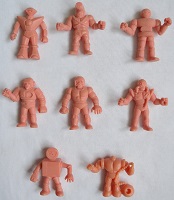



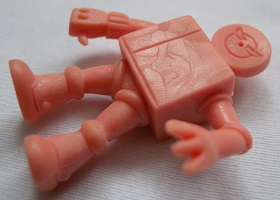
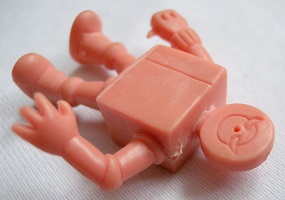
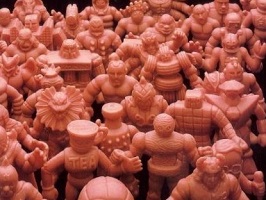
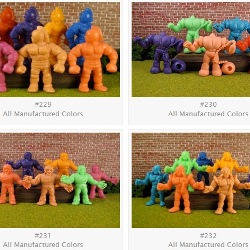
#1 by Nick...bones on February 5, 2017 - 9:33 am
Well I’m sure I don’t have the answers but the figure in pic 7 and 8 looks to be a legit muscle fig in salmon.
It’s has very clean definition, the injection marks look right, and I don’t see anything unusual in the way off flashing or tags.
The blisters he is talking about appear to be tags.
Places where the figure was cut away from the tree.
I do have a question though…why does Jason believe that they are all factory rejects?
I have 2 full sets of flesh with many extra.
Most have some sort of “defect” in the way of flow.
A bunch actually have different sheen on the surface…
I.e. spots that are shiny and spots that are flat on the same figure.
#2 by Lucas on February 6, 2017 - 6:35 am
Many bootlegs of Kinkeshi and M.U.S.C.L.E. are done hastily and with little to no quality control. Most producers of these bootlegs did not bother to alter the sculpts they were duplicating in any way, which means that even the original trademark would still be visible, along with any other of the figure’s details. Some bootlegs, such as the high quality first series Exogini or rubbery figures with HONG KONG on their backs, have the TM removed or obscured, but most often this is not the case.
The difference in the material, i.e. it’s texture and rigidity versus that of the other figures from the same lot, would point to it being a bootleg. A size comparison with another legitimate #230 may also be helpful in determining it’s authenticity: Nearly every bootleg will be smaller in proportions to it’s original counterpart since they were cast from copies and not the original mold.
M.U.S.C.L.E. and first generation Kinkeshi have the exact same dimensions because they were cast from the very same molds.
One should also bear in mind that finding a lot of figures being sold together does not necessarily mean that they all share the same origin. They very well may have come from a single collection, but even then those figures could have been gathered at any multiple points in time prior to their being sold as a single lot, and not just by the original owner. They could have been collected over a period of years and anywhere in the world before they ended up at a store.
The geographical location of a second-hand lots may be interesting, but it can only be useful in helping to unlock some of the M.U.S.C.L.E. Mysteries when you have more data to compare against it. Factory errors have been and likely will continue to pop up everywhere these figures were sold, some still in the factory packaging even, which would not support the theory of a single area being the target zone for sub-par production runs.
Minor imperfections, such as flow marks, blistering, excess flashing, etc., are also very common among M.U.S.C.L.E. With the amount of warped and other more glaringly obvious factory errors that have been found on the open market, it is not surprise that such tiny flaws were not enough to disqualify any figures from being worthy of retail standards. As you handle more of these figures, you will notice that such small variances are inherent to all of the figures.
M.U.S.C.L.E. figures are much like snowflakes; They may appear to be uniform at a glance, but closer inspection proves that no two are exactly alike!
#3 by Jason A. on February 26, 2017 - 3:11 pm
Thank you both for your comments. The #230 figure is indeed smaller, but the #218 is not. I don’t have duplicates of the other six figures to compare them with. I’m thinking now that I was wrong to assume all those MUSCLEs at the discount toy store had the same origin. Thanks again to both of you for your insights.